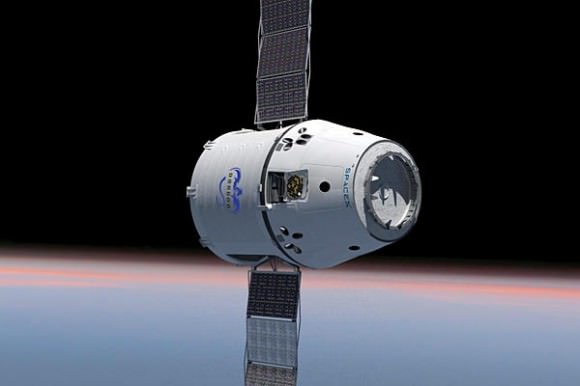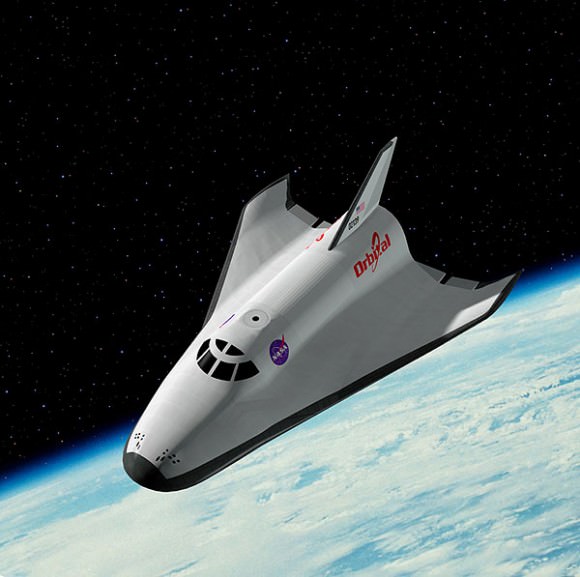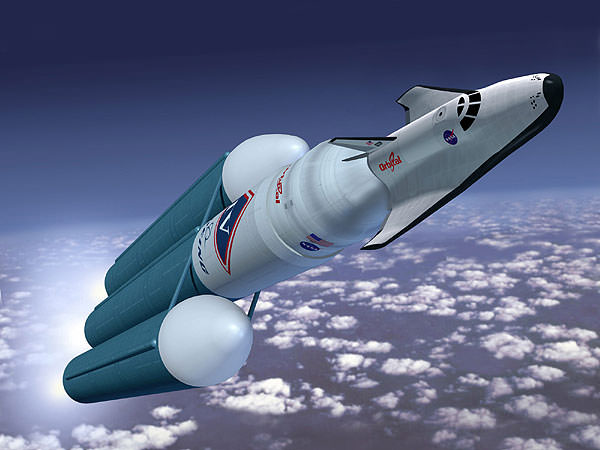[/caption]
Once, the field had only had few entries, but now there are several companies vying to send American astronauts into orbit. With NASA’s Commercial Crew Development program, or CCDev 2, and the encouragement of commercial space firms to produce their own vehicles, the number of potential ‘space-taxis’ has swelled, with virtually every established and up-and-coming aerospace company either producing – or proposing one.

One of the first firms to unveil a potential means of transportation to the International Space Station (ISS) was Space Exploration Technologies (SpaceX). SpaceX launched the first of its Dragon spacecraft on Dec. 8, and shortly thereafter became the first private company to safely recover a spacecraft after it returned from orbit.

Not to be out done by the ‘new kid on the block’ Boeing unveiled its version of a space taxi this past September. Boeing’s Crew Space Transportation-100 (CST-100) spacecraft which it described could be used for missions to the space station or other ‘LEO platforms.’ One potentially exciting prospect about this endeavor is that any excess seating capacity will be available for purchase through Space Adventures.

A step away from what most of these companies are doing, Orbital Sciences has proposed producing a ‘mini-shuttle’ to ferry passengers to and from orbit. Most aerospace companies that have submitted designs and ideas have stepped away from the space plane concept as it is now viewed as too complicated and expensive. However, the U.S. Air Force recently successfully demonstrated the viability of its unmanned X-37B space plane. It was perhaps with this in mind that emboldened Orbital to go a step further and produce a man-rated mini space plane. Orbital images show their spacecraft proposal being lifted to orbit atop a Delta IV Heavy.
Just this month Virgin Galactic also announced its plans to produce a space plane (the company uses a space plane in its sub-orbital commercial efforts – this new space plane appears to be an extension of that).

Lastly Sierra Nevada Corp also has thrown its name into the ring proposing a winged spacecraft. Their ‘Dream Chaser’ spacecraft is similar to Orbital’s proposal, a winged spacecraft that would be launched to orbit atop an expendable launch vehicle.
These companies are all vying for the $200 million that NASA has placed into a program to promote ease of access to orbit. While the Orion spacecraft, produced by Lockheed Martin, is part of a NASA program – these other organizations are hoping that by demonstrating the viability of their technology – that they can also secure a strong position in the emerging commercial space market.


If these things are ever successfully launched, that would be great. I’d have a option now to phone for a ride home in case I ever have a few too many at the pub… in Moscow. :^D
The image at top (Orbital Sciences ‘mini shuttle’) looks strikingly similar to the X-20 Dynasoar mated with a Titan IIIC, proposed in the early 60’s: http://commons.wikimedia.org/wiki/File:Dyna_Soar_launchers.png
The more that things change………
also ESA’s Hermes and Areane 5
http://proyectodeciencias.files.wordpress.com/2010/01/ariane-5-y-hermes1.jpg
What I really like about the Orbital and Sierra Nevada designs is that these space craft could potentially land at any commercially size airport then be picked up by a C-17 or AN-124 or other? The Sierra Nevada design looks like an earlier russian design? cept for the folding wings.. http://www.buran-energia.com/spiral/orbital-plane-desc.php
seems like this design has been proposed by everyone at one time or another
http://www.buran.fr/spiral/img/os10.jpg
Mere curiosity, but, unlike Spacex and Boeing, has Orbital Sciences ever actually built anything? If not, it would seem that, even if this is a great plan, they are several years behind. Just wondering, it is a pretty picture though.
Some 130 satellites, the Taurus launcher et cetera, see their web site.
Weren’t the vast majority (if not all) of both their satellites and launchers outsourced to non-American companies and assembled outside the US? It doesn’t matter to me that they outsource everything, but it does matter to me that they have nearly zero in-house experience with… anything. Orbital Sciences is nothing more than an administration company. They’re paperpushers.
Not exactly a Boeing but they’re not a P.O. box either. http://www.orbital.com/About/
I did find it interesting that selecting “Investor Relations”, a blank page (Untitled Document) results, hmm.
Exactly what I was thinking….. As I say all the time, if it aint Beoing I aint going!!
This discussion regarding Orbital is way off the mark and sounds like media or corporate subterfuge. Orbital has been designing and building rockets, orbital and suborbital, for 40+ years along with their multitudes of satellites produced here in the US. Actually Orbital’s origins have direct lineage to America’s propulsion developments through their acquisition of Space Data in the late 1980s.
Obviously the postman and gopher have no knowledge of what Orbital does and their long history of developmental successes. Ignorance is bliss …
Spacex has built 1 rocket, with 2 versions, and quite successfully (after a couple early miscues)! In about another 100 or so launches, then they can be stated in the same context of corporate successes as Boeing and Orbital.
Love the pictures and concept of Orbital’s shuttle replacement. Much more relevant than the Boeing retro capsule.
I’m sorry, but what exactly does Orbital build? Because I can’t find anything that they build themselves. They’re great at contracting everything they do out to various other companies, not so good at building anything in-house. Saying that Orbital is a rocket company is like claiming that the US Airforce builds the Atlas 5 or the Delta 4, just because they happen to utilize those launchers. Orbital doesn’t build anything, they buy rockets that other people build.
I wonder if in ten years we’ll look back and see the end of the space shuttle/ Aries cutbacks as the best thing that ever happened for spaceflight. It’s nice to see how quick private industry can fill in the vacuum left by the US govt.
That entry is a dark horse, since AFAIU you can’t scale up the current SS1/SS2 designs (plastic constructions, no heat shield, not designed for reentry).
Maybe the current entry, whatever it is, is just a space [sic!] filler for some heave development. If so, wonder what design they will go for? Another lifting body like Orbital Science’s would be somewhat close to the current ‘heritage’.
[Another topic I would love some UT digging into. What is the “SS3” entry?]
All those designs do look strikingly similar, current as well as early AF and Soviet but, when you really stop and think about it, for a manned leo servicing re-entry/landing vehicle, there’s not much that can be improved upon. Although I do like Han Solo’s ride.
… an awfully expensive taxi ride.
Also where are you going to go. Gawk at the Earth, then just come home?
The future of humanity should not be for the elite or those who can afford it!
If you ain’t there for science or humankind in general, you shouldn’t be there.
Boo!
But they are, what tickles one’s fancy will help another. When you buy electricity because you can afford it (as opposed to paupers in many nations), you support labs et cetera – the good stuff. You never know where synergies crops up.
Though I don’t see how the subject came up, these are commercial efforts directed directly to benefit international space development.
These mini-shuttles or space planes is a bit like these old Disney clips.
http://www.youtube.com/watch?v=rBgkrhnThek&feature=channel
Without a real purpose for putting these in orbit it is unclear whether any of this sort of thing warrants much attention.
LC
What is needed is a low cost way to get up to orbit. Whatever happened to the idea of launching from a high altitude, so as to save all that energy necessary from sea level ?
Tibet is a good high altitude flat plain area for launching.
And if you made a catapult, like on an aircraft carrier ship, and then angled it up a mountain, you would get a good head start, then your rocket booster would not need to be so expensive. And orbit could be achieved much more cost effectively !
Scaled Composites (SS1/SS2) and Orbital Sciences (Taurus) makes high altitude launchings from air planes.
But in US there is a big snag; you have to pay the politician’s swag; to launch at Florida sea level is a drag; but what don’t you do for the flag. [Sorry, seems I suffer from early onset holiday rhyming.]
As for the catapult, we had an IMHO good discussion recently. Short version: today’s technology comes up short, and it really doesn’t pay for itself unless you can get pass enough the atmosphere; Mt Everest may be too short.
Time to resurrect HOTOL? What a brilliant concept that was. British too!
They probably got the idea from the film Thunderbirds are Go! (1966)! 😉
It seems they copied it from either the “Zero-X” and the Fireflash
I do agree. It could still could happen!
NASA will choose from capsules and gliders for CCDev, as it did for COTS. The selection may again be driven by “Which proposals meet the requirements while offering the least complexity?” as this drives greater reliability and safety and lowers purchase and operating costs. The Atlas V Heavy / Dream Chaser and Delta IV Heavy / Orbital Science system of vertically launched gliders may be perceived as over kill.
(1) Dream Chaser is a seven seater where as the Space agencies only need to swap out three ISS crew at a time,
(2) the Delta IV Heavies cost around $200m each with a one off $500m (quoted to Orion) for man rating and at least as much for an Atlas V. Meanwhile, you get change from $60m when purchasing Falcon 9 to cover the same LEO flight path,
(3) the VTHL of a rocket launched glider offers no major advantage over the VTVL of a rocket launched capsule. Gliders can have difficulty landing during high cross winds (the same reason the Space Shuttles were sometimes forced to land at Edwards AFB and subsequently flown back to base atop a modified 747 at considerable expense) although this could be less of a worry if the proposed gliders can land on a variety of conventional run ways.
So far, NASA is approving less complex designs which explains why they eliminated the Dream Chaser from COTS phase 1. CCDev Phase 2 funds are awarded in March 2011, so not too long to wait before we know who gets cut.